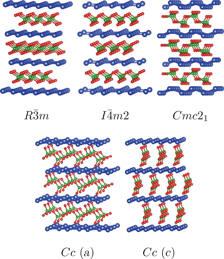Crossref Citations
This article has been cited by the following publications. This list is generated based on data provided by
Crossref.
Sanal, K.C.
and
Jayaraj, M.K.
2014.
Development of p-type amorphous Cu1−xBxO2−δ thin films and fabrication of pn hetero junction.
Materials Science and Engineering: B,
Vol. 185,
Issue. ,
p.
109.
Santra, Saswati
Das, Nirmalya Sankar
Sen, Dipayan
and
Chattopadhyay, Kalyan Kumar
2014.
CuBO2: a new highly transparentp-type wide band gap electron field emitter.
Journal of Physics D: Applied Physics,
Vol. 47,
Issue. 50,
p.
505301.
Cerqueira, Tiago F. T.
Lin, Sun
Amsler, Maximilian
Goedecker, Stefan
Botti, Silvana
and
Marques, Miguel A. L.
2015.
Identification of Novel Cu, Ag, and Au Ternary Oxides from Global Structural Prediction.
Chemistry of Materials,
Vol. 27,
Issue. 13,
p.
4562.
Sarmiento-Pérez, Rafael
Cerqueira, Tiago F. T.
Valencia-Jaime, Irais
Amsler, Maximilian
Goedecker, Stefan
Romero, Aldo H.
Botti, Silvana
and
Marques, Miguel A. L.
2015.
Novel phases of lithium-aluminum binaries from first-principles structural search.
The Journal of Chemical Physics,
Vol. 142,
Issue. 2,
Lunca Popa, P.
Crêpellière, J.
Leturcq, R.
and
Lenoble, D.
2016.
Electrical and optical properties of Cu–Cr–O thin films fabricated by chemical vapour deposition.
Thin Solid Films,
Vol. 612,
Issue. ,
p.
194.
Jiang, Tengfei
Bujoli-Doeuff, Martine
Farré, Yoann
Blart, Errol
Pellegrin, Yann
Gautron, Eric
Boujtita, Mohammed
Cario, Laurent
Odobel, Fabrice
and
Jobic, Stéphane
2016.
Copper borate as a photocathode in p-type dye-sensitized solar cells.
RSC Advances,
Vol. 6,
Issue. 2,
p.
1549.
Zia, Wasif
Siraj, Khurram
Faiz, Hafsa
and
Firdos, Atika
2019.
A facile synthesis of single phase delafossite CuBO2 powders.
Materials Research Express,
Vol. 6,
Issue. 9,
p.
096314.
Bouda, H.
Bahlagui, T.
Masrour, R.
Bahmad, L.
El kenz, A.
and
Benyoussef, A.
2019.
Unexpected magnetic behavior of Ga doped CuFe1-xGaxO2 delafossite, x = 0.04: First principle calculation and Monte Carlo simulation.
The European Physical Journal Plus,
Vol. 134,
Issue. 10,
Traiphop, Sornamol
Thongbai, Prasit
and
Kamwanna, Teerasak
2020.
Effect of synthesis method on magnetic and dielectric properties of CuBO2 delafossite oxide.
Journal of the Australian Ceramic Society,
Vol. 56,
Issue. 2,
p.
499.
Esthan, Chinnu
Nair, Bindu G.
Surya Mary, A.
Joseph, Julie Ann
Joseph, Linu Mary
Jacob, Rajani
Shinoj, V.K.
and
Philip, Rachel Reena
2022.
Transparent heterojunctions of Cu-based delafossites n-CuInO2/p-CuGaO2 by reactive evaporation method for transparent electronic applications.
Vacuum,
Vol. 197,
Issue. ,
p.
110808.
Zhu, Kaijian
Mul, Guido
and
Huijser, Annemarie
2024.
CuBO2: A Potential Alternative for NiO as a Hole Acceptor Layer.
ChemSusChem,
Vol. 17,
Issue. 2,
Das, Nirmalya Sankar
and
Chattopadhyay, Kalyan Kumar
2024.
Comprehensive Materials Processing.
p.
340.





